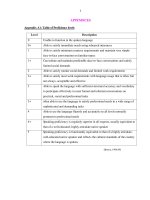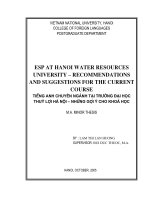MBA 5652 unit II Columbia Southern University
Bạn đang xem bản rút gọn của tài liệu. Xem và tải ngay bản đầy đủ của tài liệu tại đây (61.47 KB, 9 trang )
Running head: SUN COAST’S DILEMMA
1
Sun Coast’s dilemma
Dang Dinh Hong
Columbia Southern University
SUN COAST’S DILEMMA
2
Sun Coast’s dilemma
Introduction
Senior leadership at Sun Coast has identified several areas for concern that they believe could
be solved using business research methods. The previous director was tasked with conducting research
to help provide information to make decisions about these issues. Although data were collected, the
project was never completed. Senior leadership is interested in seeing the project through to fruition.
The following is the completion of that project, and includes statement of the dilemmas, literature
review, purpose statements, research methodology, design, and methods, research questions and
hypotheses, data analysis, and findings.
Statement of the Problems/Dilemmas
There were six business dilemmas identified.
Particulate Matter (PM)
There is a concern that job-site particle pollution is adversely impacting employee health.
Although respirators are required in certain environments, particulate matter (PM) varies in size
depending on the project and job site. PM between 10 and 2.5 microns can float in the air for minutes
to hours (e.g. asbestos, mold spores, pollen, cement dust, fly ash), while PM less than 2.5 microns can
float in the air for hours to weeks (e.g. bacteria, viruses, oil smoke, smog, soot). Due to the smaller size
of PM less than 2.5 microns, it is potentially more harmful than PM between 10 and 2.5 since the
conditions are more suitable for inhalation. PM less than 2.5 are also able to be inhaled into the deeper
regions of the lungs, potentially causing more deleterious health effects. It would be helpful to
understand if there is a relationship between PM size and employee health. Air quality data have been
collected from 103 job sites, which is reflected in PM size. Data is also available for average annual
sick days per employee per job-site.
SUN COAST’S DILEMMA
3
Safety Training Effectiveness
Health and Safety training is conducted for each new contract that is awarded to Sun Coast.
Data for training expenditures and lost-time hours were collected from 223 contracts. It would be
valuable to know if training has been successful in reducing lost-time hours and, if so, how to predict
lost-time hours from training expenditures.
Sound-Level Exposure
Sun Coast’s contracts generally involve work in noisy environments due to a variety of heavy
equipment being used for both remediation and the clients’ ongoing operations on the job sites.
Standard ear-plugs are adequate to protect employee hearing if the decibel levels are less than 120
decibels (dB). For environments with noise-levels exceeding 120 dB, more advanced and expensive
hearing protection is required, such as ear-muffs. Data have been collected for the primary variables
that are believed to contribute to excessive noise. It would be important if these data could be used to
predict the dB levels of work environments before placing employees on site.
New Employee Training
All new Sun Coast employees participate in general health and safety training. The training
program was revamped and implemented six months ago. Data is available for two Groups; a) Group A
employees who participated in the previous training program, and b) Group B employees who
participated in the revised training program. It is necessary to know if the revised training program is
more effective than the prior training program.
Lead Exposure
Employees working on job sites to remediate lead must be monitored. Lead levels in blood are
measured as micrograms of lead per deciliter of blood (μg/dL). A base-line is taken pre-exposure, then
post-exposure at regular intervals, and at the conclusion of the remediation. Data are available for 49
SUN COAST’S DILEMMA
4
employees who recently concluded a two-year-long lead remediation project. It is necessary to
determine if blood lead levels have increased.
Return-On-Investment
Sun Coast would like to know if all lines of service provide the same return-on-investment.
Return-on-investment data is available for air monitoring, soil remediation, water reclamation, and
health and safety training. If return-on-investment is not the same for all lines of service, it would be
helpful to know were differences exist.
Literature Review
Lung cancer, cardiopulmonary mortality, and long-term exposure to fine particulate air
pollution
C Arden Pope III, Richard T Burnett, Michael J Thun, Eugenia E Calle, Daniel Krewski, Kazuhiko Ito,
George D Thurston. Jama 287 (9), 1132-1141, 2002
Context Associations have been found between day - to - day particulate air pollution and
increased risk of various adverse health outcomes, including cardiopulmonary mortality. However,
studies of health effects of long-term particulate air pollution have been less conclusive. Objective To
assess the relationship between long-term exposure to fine particulate air pollution and all-cause, lung
cancer, and cardiopulmonary mortality. Design, Setting, and Participants Vital status and cause of death
data were collected by the American Cancer Society as part of the Cancer Prevention II study, an
ongoing prospective mortality study, which enrolled approximately 1.2 million adults in 1982.
Participants completed a questionnaire detailing individual risk factor data (age, sex, race, weight,
height, smoking history, education, marital status, diet, alcohol consumption, and occupational
exposures). The risk factor data for approximately 500 000 adults were linked with air pollution data
for metropolitan areas throughout the United States and combined with vital status and cause of death
data through December 31, 1998.Main Outcome Measure All-cause, lung cancer, and cardiopulmonary
SUN COAST’S DILEMMA
5
mortality. Results Fine particulate and sulfur oxide–related pollution were associated with all-cause,
lung cancer, and cardiopulmonary mortality. Each 10-µg/m3 elevation in fine particulate air pollution
was associated with approximately a 4%, 6%, and 8% increased risk of all-cause, cardiopulmonary, and
lung cancer mortality, respectively. Measures of coarse particle fraction and total suspended particles
were not consistently associated with mortality. Conclusion Long-term exposure to combustion-related
fine particulate air pollution is an important environmental risk factor for cardiopulmonary and lung
cancer mortality.
Length of occupational noise exposure and blood pressure.
Thierry Lang, Christiane Fouriaud, Marie-Christine Jacquinet-Salord. International archives of
occupational and environmental health 63 (6), 369-372, 1992
A cross-sectional study was performed in the Paris area, with a total of 7901 subjects; 432 of
them were exposed to occupational noise ≥ 85 dBA. Noise was measured by the worksite physicians,
and length of exposure was collected through interview. The subjects exposed to noise were mainly
workers, their body mass index was higher and their job characteristics different from the other
subjects, assembly line, shift-work and job under time pressure being more frequent. Blood pressure
(BP) was higher among the exposed subjects; this was no longer the case after adjustment for age, body
mass index and alcohol intake. Taking length of exposure into account, BP and the prevalence of
hypertension increased for durations ≥ 25 years. This relationship was still significant after adjustment
for age, body mass index and alcohol intake. These results suggest that a long occupational noise
exposure is a risk factor for high blood pressure.
Chronic occupational exposure to lead and its impact on oral health
Khaled F El-Said, Amina M El-Ghamry, Nehad H Mahdy, Nagwa A El-Bestawy. J Egypt Public Health
Assoc 83, 451-466, 2008
SUN COAST’S DILEMMA
6
Chronic Lead exposure favours the formation of cheilitis, fissures, ulcers and epithelial
desquamation of the tongue, palate and other parts of the oral mucous membranes. The tissues of oral
cavity may be affected by toxic agents either by direct action as in exposure to sulfuric acid fumes or
through systemic exposure as in poisoning with heavy metals eg lead.. The Present study aimed to
investigate the oral health condition of industrial workers exposed to lead in Alexandria governorate.
The samples included all workers chronically exposed to lead fumes or dust in a storage battery plant
(400 workers) and working in seven departments where lead exposure was present. These departments
were evaluated environmentally for lead in air and their workers for lead in blood. Oral medical
examinations were carried out according to the items of WHO sheet designed for oral health survey
with some modifications. Results of the present study revealed that chronic exposure to lead
significantly affects oral health condition among exposed workers and strongly correlates with
increasing level of blood lead among them. It can be concluded that the most common adverse effects
of lead on dental health of exposed workers were the significant increase in the prevalence of
periodontal diseases (gingivitis and periodontitis expressed as PI) and in the prevalence of decay
(caries), missed and filled teeth (expressed as DMFT index) and dental
An empirical analysis of the effectiveness of occupational health and safety management
systems in SMEs.
Pablo Arocena, Imanol Núñez. International Small Business Journal 28 (4), 398-419, 2010
This article analyses the effectiveness of occupational health and safety (OHS) management in
small and medium-sized enterprises (SMEs). In particular, we (1) provide an overview of the
implementation of occupational risk preventive activities in a sample of SMEs; (2) characterize
alternative approaches of OHS management systems; (3) assess the effectiveness of the identified OHS
systems in occupational safety outcomes; and (4) analyse the factors affecting the adoption of such
SUN COAST’S DILEMMA
7
OHS systems. The study is based on primary data obtained by means of a survey on OHS management
in 193 Spanish manufacturing SMEs. The analysis disentangles differences between the OHS activity
of small-sized enterprises (SSEs) — those under 50 employees — and medium-sized enterprises
(MSEs) — 50—250 employees. We find evidence that the effort and type of OHS management system
does significantly affect the injury rate. More specifically, firms that complement traditional technical
preventive activities with people and organization-oriented procedures are the most effective in
reducing occupational accidents. Such advanced OHS systems are significantly less developed in SSEs.
Our results also reveal that the choice of OHS system is determined by the quality of industrial
relations, rate of unionization, intensity of price-based competition, access to public aid and training
activities provided by the OHS public agencies, technology intensity, and the manual nature of
workers’ tasks.
Research Objectives
Sun Coast is facing a lot of problems. These issues are affecting the operations of the company
such as: personnel, cost, revenue, performance.
Specifically, the issues that Sun Coast encountered were: Noise, Particles matter, Safety,
Training, Lead exposure, Return - on - Investment.
The focus of this study was on employees' illness-related absences and sought opportunities for
the company to reduce costs and employee absenteeism due to working conditions.
Research Question and Hypotheses
The study answers research question as well as a null and alternative hypothesis as below:
Research Question One
RQ1: Is there a relationship between size of PM and number of employee’s sick day?
H01: There is a relationship between size of PM and number of employee’s sick day.
HA1: There is not a relationship between size of PM and number of employee’s sick day.
SUN COAST’S DILEMMA
8
Research Question Two
RQ2: Is there a predictive/causal relationship between lost time hour and training expenditure?
H02: There is not a predictive/causal relationship between lost time hour and training
HA2: There is a predictive/causal relationship between lost time hour and training expenditure.
Research Question Three
RQ3: Is there a predictive/causal relationship between primary variables (velocity…) and dB levels of
work environment?
H03: There is not a predictive/causal relationship between primary variables (velocity…) and dB
levels of work environment.
HA3: There is a predictive/causal relationship between primary variables (velocity…) and dB levels of
work environment.
Research Question Four
RQ4: : Is the revised training more effective than prior training?
H04: The revised training is no more effective than the prior training
HA4: The revised training is more effective than the prior training
Research Question Five
RQ5: Is there a positive effectiveness of the revised training in comparison to the prior training?
H05: There is no effectiveness of the revised training in comparison to the prior training.
HA5: There is a positive effectiveness of the revised training in comparison to the prior training
Research Question Six
RQ6: Whether the blood lead level increase after 2-year-long lead remediation project?
- Is there an increase of blood lead levels after 2-year-long lead remediation project?
H06: The blood lead level does not increase after 2-year-long lead remediation project.
HA6: The blood lead level increase after 2-year-long lead remediation project.
SUN COAST’S DILEMMA
9
References
Creswell, J. W., &Creswell, J. D. (2018).
Research design: Qualitative, quantitative, and mixed method approaches (5th ed.). Los Angeles, CA:
Sage.
C Arden Pope III, Richard T Burnett, Michael J Thun, Eugenia E Calle, Daniel Krewski,
Kazuhiko Ito, George D Thurston. (2002) Jama 287 (9), 1132-1141.
Khaled F El-Said, Amina M El-Ghamry, Nehad H Mahdy, Nagwa A El-Bestawy.( 2008) J Egypt Public
Health Assoc 83, 451-466.
Pablo Arocena, Imanol Núñez. (2010) International Small Business Journal28 (4), 398-419.
Thierry Lang, Christiane Fouriaud, Marie-Christine Jacquinet-Salord. (1992). International archives of
occupational and environmental health 63 (6), 369-372.









